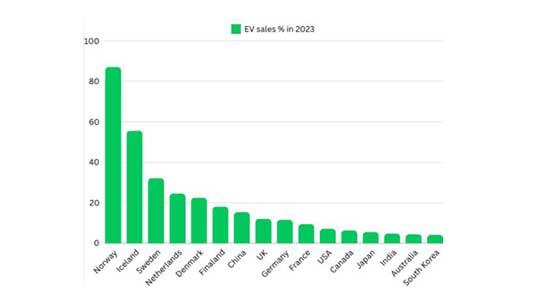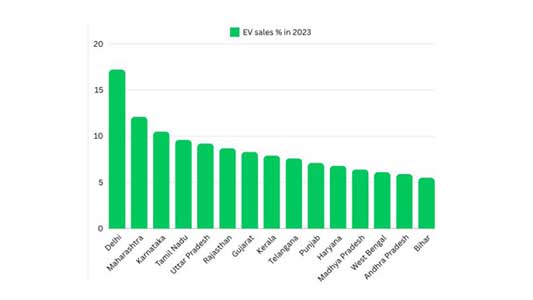
The transportation sector is one of the largest contributors to greenhouse gas emissions, accounting for nearly 25% of global carbon emissions. As concerns about climate change and air pollution grow, the need to transition to low-carbon energy sources in transportation has become increasingly urgent. This article compares the status of low-carbon energy in transportation in India and globally, highlighting trends, challenges, and opportunities.
Global Status
Globally, low-carbon energy in transportation is gaining momentum. Electric vehicles (EVs) have emerged as a leading solution, with over 40 million EVs on the road worldwide. Many countries have set ambitious targets to phase out internal combustion engines. Norway aims for 100% EV sales by 2025. The UK and France plan to ban petrol and diesel cars by 2030. China, the world’s largest EV market, targets 50% EV sales by 2035.

Alternative fuels like hydrogen, biofuels, and liquefied natural gas (LNG) are also gaining traction. Investment in low-carbon transportation infrastructure, such as charging stations and hydrogen fuelling stations, is increasing rapidly.
India’s Status
India, with its vast population and growing economy, faces unique challenges in transitioning to low-carbon energy in transportation. However, the country has made significant strides. EV sales are growing rapidly, with over 4 million EVs on Indian roads. The Central government’s Faster Adoption and Manufacturing of Electric Vehicles (FAME) scheme provides incentives for EV adoption. India aims for 30% EV sales by 2030. Over 20 states and union territories having EV policies in place. These policies vary in scope and objectives, but most aim to improve air quality, mitigate climate change, reduce dependence on oil imports, and develop India’s EV industry. These policies offer various incentives, such as capital subsidies, exemptions from vehicle registration fees, road taxes, and parking charges, to encourage the adoption of EVs. Some states, like Maharashtra and West Bengal, have also proposed non-fiscal incentives, including the creation of green zones, reserved parking for EVs, and incentives for efficient charging infrastructure rollouts. The country is promoting alternative fuels like ethanol, biodiesel, and compressed natural gas (CNG).

Comparative Analysis
While India has made progress, it lags behind global leaders in low-carbon transportation. India’s EV penetration though on the rise in recent years, the market share is around 7%, compared to Norway’s 90% and China’s 35%. India has approximately 1,500 charging stations, whereas China has over 1.8 million public charging stations. Global leaders have more comprehensive policies and regulations supporting low-carbon transportation. EVs are still more expensive than traditional vehicles. India’s EV financing market is growing with more participation from banks and financial institutions offering low interest rates for EV loans.
Initiatives by Government of Telangana
Telangana State Electric Vehicle and Energy Storage Systems policy 2020-2030 aims to encourage the adoption of electric vehicles in the state. The policy provides various incentives, including:
- Exemption from Road Tax: for electric vehicles purchased and registered in Telangana
- Registration Fee Exemption: for electric vehicles, making it more affordable for citizens to switch to eco-friendly options
- Retro-fitment Incentive: for the first few electric vehicles purchased and registered in the state
The policy also targets a planned migration to electric vehicles, with a goal of:
- 100% Electric Public Transport: by 2030, promoting sustainable and environmentally friendly transportation
- 100% Electric Shared Mobility Services: by 2030, reducing carbon footprint and improving air quality
These initiatives are part of Telangana’s efforts to promote electric vehicles and reduce dependence on fossil fuels. The policy builds upon the FAME II scheme implemented by the Department of Heavy Industries, Government of India.
Government of Telangana was the first Indian state to commit to the Global Drive to Zero MoU, to help transition 30% of new Medium and Heavy duty truck sales to electric by 2030, and 100% by 2040, at COP26.
Telangana took a giant leap towards a comprehensive EV ecosystem with the launch of Telangana Mobility Valley (TMV), aiming to attract INR 50,000 crore in investments over five years. As a hub for sustainable mobility innovation, the state prioritizes Zero Emission Trucks, crucial for reducing emissions and improving air quality. The Telangana Zero Emission Trucking (ZET) Accelerator, a key TMV initiative, unites stakeholders to pilot and implement ZET projects statewide, driving a cleaner, greener future.
Opportunities
Despite challenges, India offers significant opportunities. Market potential is large with India’s growing middle class and urbanization drive demand for transportation solutions. Initiatives like PM E-DRIVE, Electric Mobility Promotion Scheme, FAME-2 and the National Electric Mobility Mission Plan (NEMMP) provide a framework for growth. India is home to a thriving startup ecosystem, driving innovation in EVs and alternative fuels.
Conclusion
Low-carbon energy in transportation is crucial for mitigating climate change and improving air quality. While India faces challenges, the country has made significant progress. To bridge the gap with global leaders, India must strengthen policy frameworks and regulations, invest in charging infrastructure and alternative fuel production, encourage innovation, entrepreneurship and research and development in low-carbon transportation technologies. Above all, India must develop a comprehensive low-carbon transportation policy.
As the world transitions to a low-carbon future, India has the potential to emerge as a leader in sustainable transportation. By adopting these strategies, India can accelerate its transition to low-carbon energy in transportation, contributing to a cleaner, healthier, and more sustainable future.
References
1. International Energy Agency (IEA). (2022). Global EV Outlook 2022.
2. Ministry of Heavy Industries, Government of India. (2022). Faster Adoption and Manufacturing of Electric Vehicles (FAME) Scheme.
3. National Institution for Transforming India (NITI Aayog). (2022). India’s Energy Transition.
4. Bloomberg New Energy Finance (BNEF). (2022). Electric Vehicle Outlook 2022.
5. Telangana Electric Vehicle and Energy Storage System policy 2020-2030












